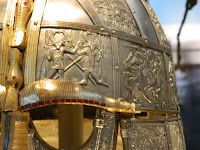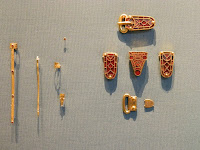
 The Sutton Hoo burial was discovered in 1939 after exploration of largest burial mound at Edith Pretty's estate at Suffolk. Inside the mound, the imprint of a 27-metre-long, decayed ship, studded with iron rivets containing burial chamber was found. The burial took place in early AD 600s, when Sutton Hoo belonged to East Anglia, one of competing Anglo - Saxon kingdoms. Sutton Hoo is the most significant find from early medieval Europe, also the richest, containing many artifacts of exquisite craftsmanship, probably commemorating a person of extreme wealth or high status, possibly an Anglo-Saxon King of East Anglia.
The Sutton Hoo burial was discovered in 1939 after exploration of largest burial mound at Edith Pretty's estate at Suffolk. Inside the mound, the imprint of a 27-metre-long, decayed ship, studded with iron rivets containing burial chamber was found. The burial took place in early AD 600s, when Sutton Hoo belonged to East Anglia, one of competing Anglo - Saxon kingdoms. Sutton Hoo is the most significant find from early medieval Europe, also the richest, containing many artifacts of exquisite craftsmanship, probably commemorating a person of extreme wealth or high status, possibly an Anglo-Saxon King of East Anglia.
 Sutton Hoo helmet is one of just four complete helmets discovered from Anglo-Saxon England. Reconstructed from shattered condition in which it was found. The helmet consists of an iron cap with a crest, neck guard, cheek pieces and face mask. It was originally covered with tinned copper alloy panels, decorated with animal and warrior motifs. Similar helmets are known from eastern Sweden, what indicates traditions and culture being shared with East Anglia. Small number of such helmets suggests those of great wealth an status could only afford them.
Sutton Hoo helmet is one of just four complete helmets discovered from Anglo-Saxon England. Reconstructed from shattered condition in which it was found. The helmet consists of an iron cap with a crest, neck guard, cheek pieces and face mask. It was originally covered with tinned copper alloy panels, decorated with animal and warrior motifs. Similar helmets are known from eastern Sweden, what indicates traditions and culture being shared with East Anglia. Small number of such helmets suggests those of great wealth an status could only afford them.
Helmet reconstruction shows splendor of the original piece. Bright and silvery surface shows imagery combining Germanic, Scandinavian and even Roman-derived motifs. It was well designed and fully working piece of armour. The puzzle of creatures is implicated in the 'eyebrows', 'nose' and 'mustache'. Flying beast, with edged wings, serpent like creature forming the helmet's crest with wingtips end in fierce boar heads. Animals such as depicted on the helmet were used for protective qualities.
Shield, which is partly reconstructed, is the most elaborate shield to survive from the period. The metal rim and gilded copper alloy, gold and garnet fittings are unusual. The iron boss protected the hand, mounts depicting bird of prey and dragon may have had symbolic protection. Original lime wood board with animal hide has dissolved and was replaced by modern replica. There are similarities to Swedish shields, especially iron boss and decorative strips on the front.
In early Anglo-Saxon England swords were the most prized weapons of all, being given as gift from lords and passed as heirlooms. Sutton Hoo sword (also replica of the edge is displayed) is the finest from the period, double bladed, iron edge fitted with gold hilt pieces, decorated with garnets imported from southern Asia, set into gold cells.
Sixteen pieces of silver tableware found within the burial are from Byzantine Empire, reaching Sutton Hoo through gift exchange between rulers of Europe, bringing Bizatine luxuries to Frankish realm and onwards to Anglo-Saxon England. At early Anglo-Saxon times silver tableware was a display of status or royal treasure, as wood or horn were used instead.
Two drinking horns were reconstructed, with original gilded silver mounts and depict interlacing beasts and human faces. Tips are shaped like fierce birds' heads. The horns probably came from an aurochs, a large type of ox, which may have been imported from the Continent. Each horn held about two litres of mead or ale and may have been passed around in feasting rituals.
Lyre replica, an musical instrument made from maple wood with six strings, strummed or plucked to make music. Gilded and garnet-inlaid plaques with birds' heads embellish the top. Replica shows how the lyre may have looked like originally. Music was used for pleasure and people recited stories and poems to the accompaniment of instruments.
The form of the long carved whetstone and glittering shoulder-clasps evoke Roman symbols of authority, possibly a deliberate attempt to associate Anglo-Saxon owner with the might of the old Roman Empire.
Shoulder-clasps displayed the power and authority of the wearer. Similar to those used in Roman forms of military dress, attached to a thick or padded garment using loops at the back. Made in two halves each one is decorated with cells inlaid with garnets and patterned millefiori glass. They are hinged around central animal-headed pin and shaped to fit the shoulder.
Gold mounts and buckle and strap fittings that came from a leather belt or a harness that held the purse and sword.
Purse lid, attached to a leather pouch worn at a waist belt. Frankish coins were found inside.
Frankish coins, melted down for gold, belt buckle and sword belt pieces show Anglo-Saxon interaction with Franks from Merovingian dynasty in the early AD 600s.
The burial contained three hanging bowls of differing size and decoration. It is unknown where these were made, but decoration and form suggests Celtic-speaking regions of Ireland or north and west Britain. Bowls may have held water for hand-washing. Hanging bowls were highly prized by Anglo Saxons, with examples being found in their graves, reflecting interactions with Celtic peoples. Bowls from Sutton Hoo burial show signs of repair, what suggests a cherished possession.




























Hi there. Any chance you would grant a Creative Commons license for any of these great photos of the Sutton Hoo helmet for use on the wikipedia page about it (en.wikipedia.org/wiki/Sutton_Hoo_helmet)? In particular I would like to use the side view of the replica, which shows the design elements well (not to mention part of the back of the helmet, which is hard to find photographs of).
ReplyDeleteIf that would work for you, a "CC-BY-SA 4.0" license would be ideal. It would leave you with the copyright, but license the photo(s) for use by anyone, so long as they provide you with attribution, and, if they create a derivative work from it, release that work under the same license. Completely understand if you would rather not license the photograph(s), however.
Thanks!
Hi,
DeleteCannot see any problems with granting the license, please specify which pictures by number (numbers are visible in gallery view).
Cheers,
Mike
Thanks Mike! A CC-BY-SA 4.0 license for photograph #9, and possibly #12, would be ideal.
ReplyDeleteNo problem for both, 9 and 12 pictures license is granted. Please send me a link after :) Also, please add information that this object is from British Museum collection, London.
Delete